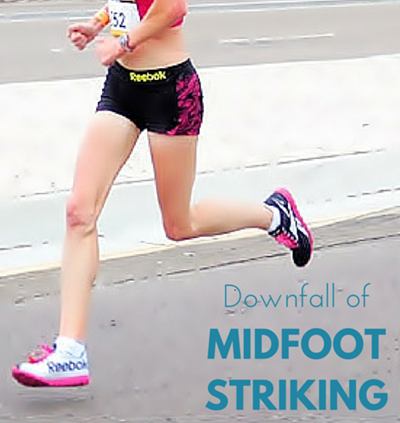Switching from a heel strike to midfoot strike (instead of a forefoot strike) is not enough to protect against running injury or improve performance.
Downfall of Midfoot Strike
Have you ever heard of the Midstance to Midstance Running technique? Neither have I, but apparently it is a ‘novel’ running technique that may help heel strikers avoid heel strike during running.
According to a recent study by Craighead et al. the Midstance to Midstance Running (MMR) technique shares similar biomechanical traits to Chi and Pose Running in that the MMR technique discourages a heel strike landing, but encourages a midfoot, not a forefoot strike landing.
So how effective is the MMR technique (aka midfoot strike running) at improving performance and injury prevention?
Midfoot Strike Does Not Improve Performance
In the same study, the researchers found that after an 8-week training period using the MMR technique, no significant changes in running economy occurred when the runners switched from heel strike to midfoot strike. Even though running economy did not decrease, it did not improve with the MMR technique.
Midfoot Strike Does not Prevent Injury
The most effective method to prevent running injury during running is to avoid making initial contact on the heel. Instead, to reduce braking, compressive forces and vertical peak impact, initial contact should be made on the forefoot during running.
The problem with a midfoot strike is that even though the entire plantar surface makes initial contact with the ground, quite often and unknowingly, the heel makes initial contact, but initial heel contact is significantly less pronounced compared to an actual heel strike landing.
- This especially holds true when heel strikers switch to midfoot strike running (they maintain the habit of heel striking) and was supported in the current study whereby 40% of the heel strike runners maintained heel strike after MMR training!

The researchers also found that the MMR runners showed reduced knee flexion at initial contact.
- Reduced knee flexion is associated with greater impact loading because the mass of the contacting leg increases.
Similarly, heel strike runners show reduced knee flexion at initial contact which restricts the capacity of the lower leg to attenuate shock thereby contributing to injuries such as runners knee and tibial stress fractures.
Therefore, biomechanically, midfoot strike running is a variant of heel strike running! To shield against injury and improve performance, changing from a heel strike to a midfoot strike in not enough. Midfoot strike running is common in American and Canadian runners where the running-related injury rates are high, but the midfoot strike is relatively uncommon in barefoot running populations as most habitual barefoot runners use a forefoot strike landing instead.
Why Forefoot Running is Better
Forefoot running reduces impact loading in two ways: 1. knee flexion at initial contact is lower and 2. the upper body is more aligned at initial contact. Therefore, the horizontal distance between initial contact position and the center of mass (upper body) is very small and is how braking along with the other harsh forces related to both heel strike and midfoot strike running are minimized. The researchers concluded that with the MMR technique, a midfoot strike landing has implications to injuries because it increases knee flexion velocity.
The Take Home Message
Changing from heel strike to midfoot strike running may give way to disappointment as midfoot strike running appears to bare similar biomechanical variables to heel strike running. Forefoot running is a better way to directly bypass the debilitating side-effects associated with the landing strategies of both midfoot and heel strike running.
More From Run Forefoot:
Stores that Sell Vibram Five Fingers
References:
Craighead DH., Lehecka N and King, DL. A novel running mechanic’s class changes kinematics, but not running economy. J Stren Cond Res, 2014; 28(11):3137-3145.
De Wit, B, De Clercq, D, and Aerts, P. Biomechanical analysis of the stance phase during barefoot and shod running. J Biomech 33:269–278, 2000.
Fletcher, G, Romanov, N, and Bartlett, R. Pose method technique improves running performance without economy changes. Int J Sports Sci Coaching 3: 365–380, 2008.
Bretta Riches
BSc Neurobiology; MSc Biomechanics candidate, ultra minimalist runner & founder of RunForefoot. I was a heel striker, always injured. I was inspired by the great Tirunesh Dibaba to try forefoot running. Now, I'm injury free. This is why I launched Run Forefoot, to advocate the health & performance benefits of forefoot running and to raise awareness on the dangers of heel striking, because the world needs to know.
Latest posts by Bretta Riches (see all)
- Does Foot Strike Really Matter in Running? YES! - 17/04/2024
- Heel Lifts Increase Injury in Runners - 16/04/2024
- Are Minimalist Shoes Good for Seniors? YES! - 14/04/2024


Leave a Reply